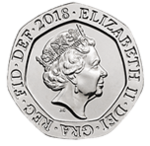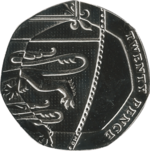Twenty pence (British coin) facts for kids
| United Kingdom | |
| Value | £0.20 |
|---|---|
| Mass | 5.0 g |
| Diameter | 21.4 mm |
| Thickness | 1.7 mm |
| Edge | Plain |
| Composition | Cupro-nickel (1982–present) |
| Years of minting | 1982–present |
| Obverse | |
 |
|
| Design | Queen Elizabeth II |
| Designer | Jody Clark |
| Design date | 2015 |
| Reverse | |
 |
|
| Design | Segment of the Royal Shield |
| Designer | Matthew Dent |
| Design date | 2008 |
The British twenty pence coin, often called 20p, is a coin worth one-fifth of a pound. This means five 20p coins add up to £1. Like the 50p coin, it has a special seven-sided shape with curved edges. The front of the coin has shown Queen Elizabeth II since it was first made on June 9, 1982.
Four different pictures of the Queen have been used on the 20p coin. The newest design, made by Jody Clark, started appearing in 2015. The back of the coin, which shows part of the Royal Shield, was updated in 2008.
In March 2014, there were about 2.7 billion 20p coins being used. Their total value was over £553 million. A small number of these coins, between 50,000 and 200,000, are special "undated" coins. These were made by mistake in 2008 when old and new coin designs were mixed up.
No new 20p coins were made for general use in 2017. This happened because a new one pound coin was introduced. People started emptying their coin jars to get rid of the old £1 coins. This put many 20p coins back into circulation.
Contents
What Does the 20p Coin Look Like?
The first design for the back of the 20p coin was used from 1982 to 2008. It was created by William Gardner. This design showed a crowned Tudor rose, which is a famous English symbol. Below the rose was the number "20", and above it were the words "TWENTY PENCE".
The front of the coin, called the obverse, has had three different main designs of Queen Elizabeth II. On coins made before the 2008 redesign, the words "ELIZABETH II D.G.REG.F.D." were written around the Queen's portrait. Coins made after 2008 also have the year they were made on the front.
Queen Elizabeth II's Portraits
- 1982 to 1984: The first portrait of Queen Elizabeth II was by Arnold Machin. In this picture, the Queen wears the 'Girls of Great Britain and Ireland' Tiara.
- 1985 to 1997: The second portrait was by Raphael Maklouf. Here, the Queen wears the George IV State Diadem.
- 1998 to 2015: The third portrait was by Ian Rank-Broadley. This one also showed the Queen wearing the 'Girls of Great Britain and Ireland' Tiara. You can see the letters "IRB" below the portrait.
- 2015 to Present: Since June 2015, coins with a portrait by Jody Clark have been in use.
The Royal Shield Design
In 2005, the Royal Mint held a competition to create new designs for many British coins. The winner, announced in 2008, was Matthew Dent. His designs were slowly introduced starting in mid-2008.
The designs for the 1p, 2p, 5p, 10p, 20p, and 50p coins show parts of the Royal Shield. When you put all these coins together, they form the complete shield. The 20p coin shows the middle part of the shield. It features the lions of Scotland and the lions of England. With this new design, the year the coin was made moved from the back to the front of the coin.
What is Legal Tender?
The 20p coin is considered legal tender for amounts up to £10. This means if you owe someone money, they must accept 20p coins for debts up to £10. However, "legal tender" has a very specific meaning in the UK. It mostly applies to paying back debts.
It does not mean that a shop has to accept a certain type of money. A shop owner can choose what types of payment they will accept. So, while 20p coins are legal tender, a shop can still decide not to take them for your everyday shopping.
The Dateless 20p Coin
In June 2009, a very unusual 20p coin was found in circulation. It had no date on it! This was the first British coin without a date to be in use for over 300 years. This happened because of a mistake during the 2008 redesign.
The date on the 20p coin was moved from the back to the front. But some coins were made using the old front design (which had no date) and the new back design (which also had no date). This type of mistake is called a "mule coin".
The Royal Mint believes that between 50,000 and 200,000 of these dateless coins were released before the error was noticed. Even though they were made by mistake, these coins are still legal tender. Because they are so rare, coin collectors often buy and sell them for much more than their face value. When they were first discovered, some were sold for thousands of pounds online. By June 2011, their value had settled to around £100.
How Many 20p Coins Have Been Made?
Here's a table showing how many twenty pence coins have been made for general use each year.
| Year | Number minted | Portrait | Reverse |
|---|---|---|---|
| 1982 | 740,815,000 | Machin | Gardner |
| 1983 | 158,463,000 | ||
| 1984 | 65,350,965 | ||
| 1985 | 74,273,699 | Maklouf | |
| 1986 | 0 | ||
| 1987 | 137,450,000 | ||
| 1988 | 38,038,344 | ||
| 1989 | 132,013,890 | ||
| 1990 | 88,097,500 | ||
| 1991 | 35,901,250 | ||
| 1992 | 31,205,000 | ||
| 1993 | 123,123,750 | ||
| 1994 | 67,131,250 | ||
| 1995 | 102,005,000 | ||
| 1996 | 83,163,750 | ||
| 1997 | 89,518,750 | ||
| 1998 | 76,965,000 | Rank-Broadley | |
| 1999 | 73,478,750 | ||
| 2000 | 136,428,750 | ||
| 2001 | 148,122,500 | ||
| 2002 | 93,360,000 | ||
| 2003 | 153,383,750 | ||
| 2004 | 120,212,500 | ||
| 2005 | 124,488,750 | ||
| 2006 | 114,800,000 | ||
| 2007 | 117,075,000 | ||
| 2008 | 11,900,000 | ||
| 115,022,000 | Dent | ||
| 2009 | 121,625,300 | ||
| 2010 | 112,875,500 | ||
| 2011 | 191,625,000 | ||
| 2012 | 69,650,030 | ||
| 2013 | 66,325,000 | ||
| 2014 | 173,775,000 | ||
| 2015 | 63,175,000 | ||
| 131,250,000 | Clark | ||
| 2016 | 212,625,000 | ||
| 2017 | 0 | ||
| 2018 | 0 | ||
| 2019 | 125,125,000 | ||
| 2020 | 32,725,000 | ||
| 2021 | 19,600,000 | ||
| 2022 | 42,875,000 |
Even in years where "0" coins are listed as minted, some 20p coins might still exist from special collector sets.


